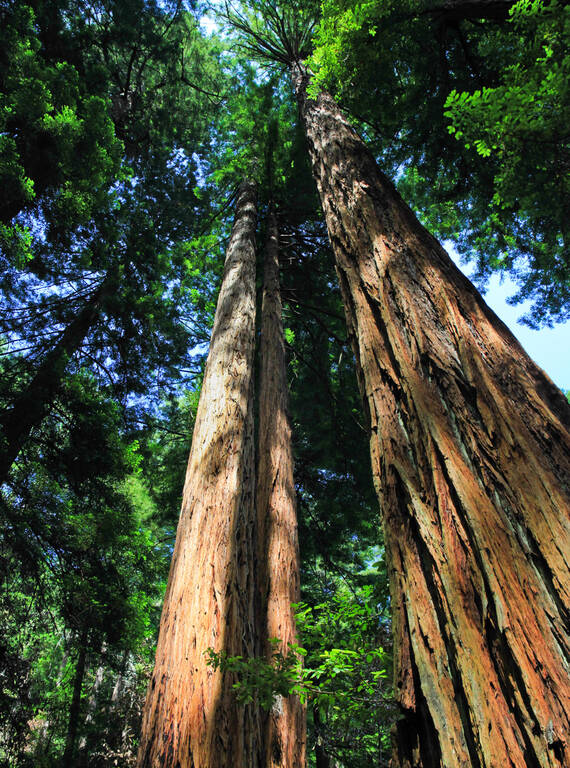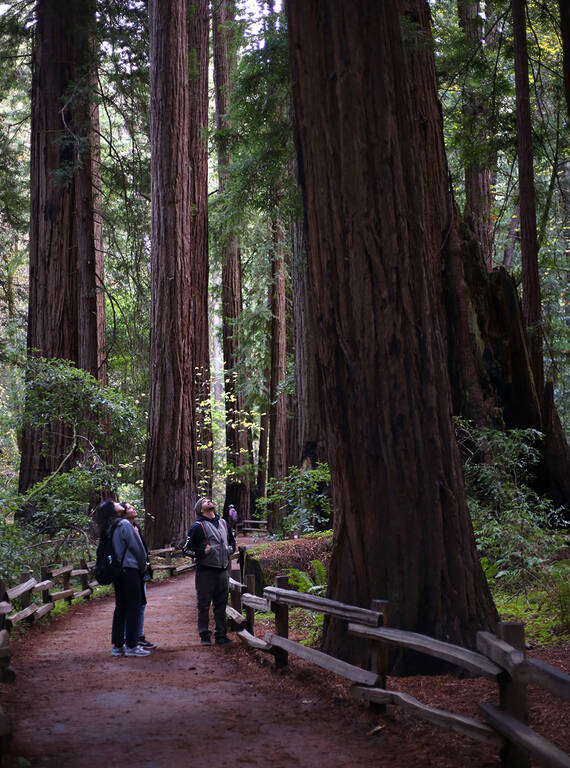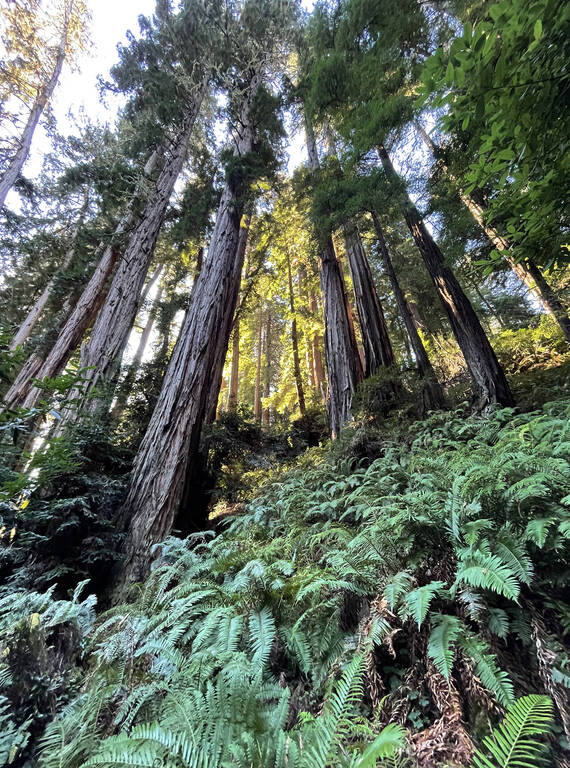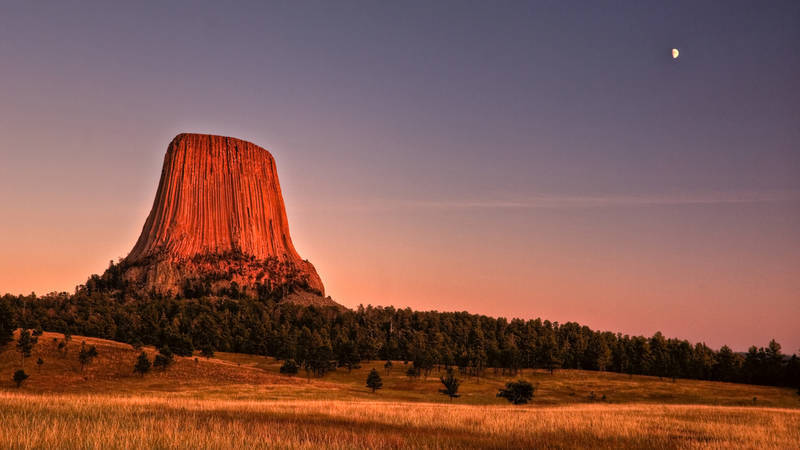Encountering some of Earth's tallest living organisms is just the beginning of visitors' experience at this California park site.
In 1903, the California Club and other women’s civic organizations banded together to save from logging several hundred acres of old-growth redwood forest in Marin County, California. The women supported William and Elizabeth Kent in purchasing the land for preservation, a conservation-minded couple who later donated the land to the federal government and recommended it be protected through the Antiquities Act.
In 1908, President Theodore Roosevelt did just that, signing a proclamation that preserved the land as a national monument. The Kents dedicated the forest to their friend John Muir, a naturalist and motivator in the U.S. government’s creation of national parks, and the magic we know as Muir Woods National Monument was born — towering, mysterious, magnificent.
Just 12 miles from the bustle of San Francisco, this patch of primeval forest is a destination for people across the globe. They come to marvel at some of the world’s tallest and oldest trees, to shake their heads at the impossible number of vertical feet and unfathomable numbers of years each tree represents. But maybe even more than that, they come to experience what can’t be represented by numbers and facts: the feeling of awe.

Muir Woods preserves one of the last few groves of giant coastal redwoods, also known as sequoias.
© Walleyelj | Dreamstime.comYou probably know the feeling, even if you can’t define it: perhaps goosebumps on your arms or a sudden silence. Maybe you feel unexpectedly small in the face of something huge or intricate, genius or ancient.
Dacher Keltner, a University of California, Berkeley professor who studies awe, defines it as “the emotion we experience when we encounter vast mysteries that we don’t understand.” In his 2023 book titled “Awe,” Keltner explains that this emotion has all manner of physiological benefits and makes people kinder to others and to the planet. We should pursue awe every day, he proposes, and not just wait to stumble upon it.
If you’re visiting Muir Woods, you already have a head start in the pursuit of awe. After all, the park’s namesake wrote in his 1939 journal, “The clearest way into the Universe is through a forest wilderness.”
Muir was a complicated figure whose racist views were not worthy of awe, but the woods named after his environmental legacy remain perennially inspirational.
“What would it take for us to be in more balance, to have more reciprocity with the ecosystems we’re a part of, so we might sustain ourselves and the other species around us?” — Ranger Jules Cooch
Yet even in a forest wilderness as breathtaking as Muir Woods, awe can be hard to access. How do we put aside the mind clutter of everyday life and open ourselves to the mystery of things we can’t fully understand? If you’re ready to give it a try, here are five strategies for chasing awe at Muir Woods National Monument.
1. Make time concrete by connecting the redwoods’ age to historical events.
Your first stop at Muir Woods should be the cross section of a redwood tree that fell in 1930 … and started growing in 909 CE. Yes, 909! You’ll see on the display that when the tree was a sapling, the Huimen, a tribe of the Coast Miwok people, lived in what is now Muir Woods. Cliff dwellings in Mesa Verde did not yet exist (1100), and Jamestown was not yet established (1607). These trees are old. And you’re in a forest full of them, literally surrounded by history.
The individual trees are just the tip of the iceberg, according to Ranger Jules Cooch, Muir Woods site supervisor and interpretive program manager. “In the fossil record, we find that the ancestors of these trees have existed on Earth for about 200 million years,” she said.
Cooch finds them a source of inspiration: “That redwoods have the adaptations and the survival mechanisms to sustain themselves on Earth for that long offers a potent reflection to humans. What would it take for us to be in more balance, to have more reciprocity with the ecosystems we’re a part of, so we might sustain ourselves and the other species around us?”
2. Touch a tree and share a tidbit of its history.
A physical encounter with history can be extraordinary — but to protect the forest, always stay on designated trails while you touch and connect with the trees.

Visitors look up at the redwoods in Muir Woods National Monument’s Cathedral Grove.
NPS/Jules CoochPaul D. Brinkman, a North Carolina State University history of science professor and museum curator, regularly touches artifacts that are unfathomably old, and he offers a trick for adjusting your brain to a new time scale. “It’s hard to wrap your mind around a thing that’s endured so far beyond a human life span,” he observed. “But imagination can help you think about incomprehensible things, help you feel awe.”
As your hand touches a tree that has witnessed many human lifetimes, let your imagination wander: Who else has touched this bark? What other creatures have passed over it or inhabited it? If this tree could talk, what would it say? What do this tree and I share, besides this one short moment?
3. Contextualize height by exploring the canopy.

Ferns and redwoods at Muir Woods National Monument.
NPS/Jules CoochRedwoods are some of the tallest trees on Earth, but just how tall are they? “I stand about 5 feet 6 inches tall,” Ranger Cooch said. “To reach the top of the canopy of the Hyperion tree [about 380 feet tall], you would have to stack me up 69 times!”
You can get a feel for this massive height with a free augmented reality app, Coast Redwood Canopy Explorer, available on Apple and Android. Created by Redwood National and State Park, the app allows you to experience scientists’ first ascent of an old-growth redwood tree and appreciate the ecosystems those trees support. It might be armchair awe, but immersing yourself in part of the park few visitors ever get to see can generate awe from your home or, if you’re a schoolteacher, your classroom.
4. Get mindful by taking a guided ‘awe walk’ in Cathedral Grove.
The park section aptly named Cathedral Grove is one of the first designated “quiet spaces” in the National Park System. Ranger Cooch said the 2008 designation was in part an effort to preserve the natural soundscape, “but it’s also an invitation to be quiet and experience the grove as a spiritual or sacred space.”
Consider taking Keltner’s guided Awe Walk in Cathedral Grove, either using headphones in person or using his 360-degree video from anywhere. The user-friendly walk can help you set aside racing thoughts and access awe in a space that deserves your full attention.
In 1945, over 500 delegates representing 46 countries who attended a San Francisco peace conference — the precursor to the United Nations — gathered in this grove for a memorial service for President Franklin D. Roosevelt. You can find a plaque that commemorates the event.
5. Talk to a ranger to see more deeply into what’s before you.
Sure, there are plenty of interpretive signs at this national monument. But there are also experts around to answer questions and meet your specific interpretive needs. “We’re here to create meaning for visitors,” Ranger Cooch said. “We’re here to help you go deeper.”

Which Presidents Have Created the Most National Monuments?
Presidents from both political parties have used the Antiquities Act to preserve natural and cultural resources. Here’s a top-10 list of presidents who have created national monuments on public lands.
See more ›Some possible questions: What is the forest like throughout the four seasons? How do people from other countries experience the redwoods? You might also ask about the Redwood Renewal project underway through 2029, in which the National Park Service is working to save the endangered coho salmon and ensure the health of the trees — and the awe they inspire in visitors — for generations to come.
As Muir said, “In every walk with nature, one receives far more than he seeks.” So, whether you leave Muir Woods with goosebumps or an entirely new life perspective, you’ve likely been shaped by what you’ve experienced. Happy exploring!
Want to visit?
Muir Woods National Monument is located in Mill Valley, California, about 12 miles from San Francisco. It was the first national monument created from land donated by a private individual. Muir Woods is open every day of the year, but its hours change seasonally. Reservations are required for personal vehicles and shuttle riders. Shuttles are offered seasonally. There is no cell service in the area, so plan accordingly.
Stay On Top of News
Our email newsletter shares the latest on parks.
About the author
-
 Susanna Klingenberg Contributor
Susanna Klingenberg ContributorSusanna Klingenberg is a freelance writer and editor based in Raleigh, North Carolina. She loves exploring outdoors, whether it's in her unruly vegetable garden or in the national parks.
-
General
-
- NPCA Region:
- Pacific